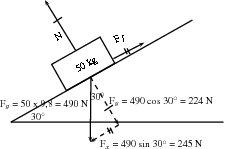| << Chapter < Page | Chapter >> Page > |
When the surface of one object slides over the surface of another, each body exerts a frictional force on the other. For example if a book slides across a table, the table exerts a frictional force onto the book and the book exerts a frictional force onto the table (Newton's Third Law). Frictional forces act parallel to surfaces.
A force is not always powerful enough to make an object move, for example a small applied force might not be able to move a heavy crate. The frictional force opposing the motion of the crate is equal to the applied force but acting in the opposite direction. This frictional force is called static friction . When we increase the applied force (push harder), the frictional force will also increase until the applied force overcomes it. This frictional force can vary from zero (when no other forces are present and the object is stationary) to a maximum that depends on the surfaces. When the applied force is greater than the maximum frictional force, the crate will move. Once the object moves, the frictional force will decrease and remain at that level, which is also dependent on the surfaces, while the objects are moving. This is called kinetic friction . In both cases the maximum frictional force is related to the normal force and can be calculated as follows:
For static friction: F N
Where = the coefficient of static friction
and N = normal force
For kinetic friction: F = N
Where = the coefficient of kinetic friction
and N = normal force
Remember that static friction is present when the object is not moving and kinetic friction while the object is moving. For example when you drive at constant velocity in a car on a tar road you have to keep the accelerator pushed in slightly to overcome the friction between the tar road and the wheels of the car. However, while moving at a constant velocity the wheels of the car are rolling, so this is not a case of two surfaces “rubbing” against eachother and we are in fact looking at static friction. If you should break hard, causing the car to skid to a halt, we would be dealing with two surfaces rubbing against eachother and hence kinetic friction. The higher the value for the coefficient of friction, the more 'sticky' the surface is and the lower the value, the more 'slippery' the surface is.
The frictional force (F ) acts in the horizontal direction and can be calculated in a similar way to the normal for as long as there is no movement. If we use the same example as in [link] and we choose to the rightward direction as positive,
A 50 kg crate is placed on a slope that makes an angle of 30 with the horizontal. The box does not slide down the slope. Calculate the magnitude and direction of the frictional force and the normal force present in this situation.
Draw a force diagram and fill in all the details on the diagram. This makes it easier to understand the problem.

The normal force acts perpendicular to the surface (and not vertically upwards). It's magnitude is equal to the component of the weight perpendicular to the slope. Therefore:
The frictional force acts parallel to the sloped surface. It's magnitude is equal to the component of the weight parallel to the slope. Therefore:

Notification Switch
Would you like to follow the 'Siyavula textbooks: grade 11 physical science' conversation and receive update notifications?